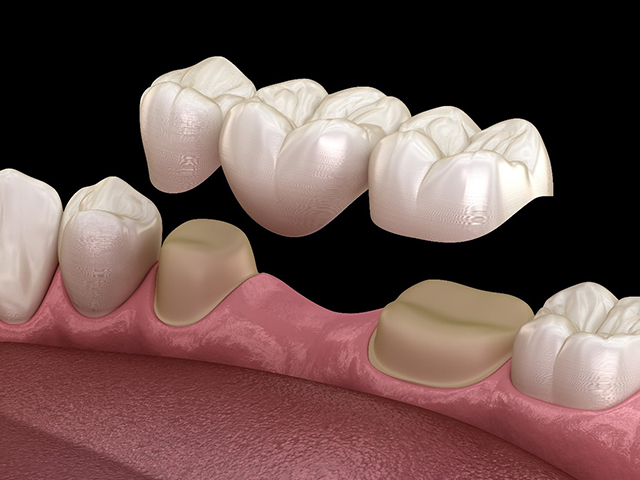
Bridging Gaps, Restoring Smiles in Greenville, SC
When a person has a severely damaged or missing tooth, their quality of life is greatly affected. While their smile may not be as beautiful as they’d like, they also are likely to suffer from low self-esteem, discomfort when eating or speaking, as well as poor oral health. If this describes you, the compassionate dental team at Cove Dental Care can help. With our affordable tooth replacement options, such as a porcelain dental bridge, you can restore the health and beauty of your smile in a comfortable, professional environment. Here’s everything you need to know about porcelain bridges before scheduling a consultation with Dr. Carraway and our experienced team in Greenville, SC.
What Is a Dental Bridge?
A dental bridge replaces missing teeth using a fixed device that consists of artificial teeth supported by dental crowns or implants. It restores function and appearance, prevents teeth from shifting, and improves your bite and speech. There are several types of dental bridges, and the process typically involves two or more appointments to prepare teeth, create a custom bridge, and cement it in place.
Why Would I Need a Dental Bridge?
You may need a dental bridge if you have one or more missing teeth. Missing teeth can cause several problems, including:
Difficulty chewing and speaking:
Missing teeth can make it difficult to chew your food properly and speak clearly.
Shifting of adjacent teeth:
When you have a missing tooth, the adjacent teeth may shift out of position, which can cause bite problems and make it difficult to clean your teeth properly.
Gum disease and tooth decay:
Gaps in your teeth can create pockets where bacteria can accumulate and cause gum disease and tooth decay.
Changes in facial structure:
Missing teeth can cause changes in the structure of your face, which can make you look older.
A dental bridge can help to restore the function and appearance of your teeth, improve your bite and speech, and prevent your remaining teeth from shifting out of position. It can also help to distribute the forces in your bite properly and prevent additional wear and tear on your teeth.
Your dentist can help you determine if a dental bridge is the right treatment option for you based on your specific needs and oral health status.
The History of Dental Bridges
The history of dental bridges is a fascinating tale that spans centuries, reflecting the evolution of dental practices and the quest to restore oral function and aesthetics. From ancient civilizations to modern innovations, dental bridges have played a crucial role in bridging the gaps left by missing teeth. This exploration delves into the historical trajectory of dental bridges, tracing their origins, advancements, and enduring significance in the world of dentistry.
Ancient Beginnings
The roots of dental bridges can be traced back to ancient civilizations that recognized the importance of restoring dental function and appearance. Archaeological findings suggest that the Etruscans, an ancient Italian civilization, were among the first to experiment with tooth replacement methods. They used materials like human or animal teeth held together by gold bands to create rudimentary dental bridges.
Egyptian Ingenuity
In ancient Egypt, the pursuit of dental restoration continued. Archaeological discoveries indicate that Egyptians utilized various materials for tooth replacement, including ivory, seashells, and even precious metals. These early attempts laid the groundwork for the concept of dental bridges, although the methods were rudimentary compared to modern standards.
Advancements in Ancient Rome
The Roman Empire witnessed further advancements in dental practices. The Roman physician Aulus Cornelius Celsus documented methods for replacing missing teeth in his medical writings. These methods involved securing replacement teeth to adjacent teeth using gold wire. While these approaches might not have been as sophisticated as contemporary techniques, they marked a significant step forward in tooth replacement methods.
A Renaissance of Knowledge
The Middle Ages brought limited progress in dentistry, but the Renaissance period ushered in a renewed interest in scientific exploration. The pioneering work of Ambroise Paré, a French surgeon, contributed to the development of dental bridges. Paré’s writings discussed methods for tooth extraction and the use of artificial teeth made from materials like ivory.
Revolutionary 18th and 19th Centuries
The 18th and 19th centuries witnessed groundbreaking advancements in dental care. Pierre Fauchard, often referred to as the “Father of Modern Dentistry,” introduced the concept of dental prosthesis. Fauchard’s innovative work laid the foundation for modern dental bridges. In the early 19th century, porcelain dentures and bridges gained prominence, thanks to the efforts of Claudius Ash, a London-based dentist. These porcelain bridges offered improved aesthetics and durability compared to previous materials.
The Advent of Modern Dentistry
The late 19th and early 20th centuries marked a turning point in dentistry with the emergence of new materials and techniques. With the introduction of dental alloys and improvements in adhesive techniques, dental bridges became more secure and natural-looking. Innovations like the casting technique and precision attachments further refined the process of creating and placing dental bridges.
Contemporary Innovations
The latter half of the 20th century brought significant technological advancements to dentistry. The introduction of dental implants revolutionized tooth replacement, offering an alternative to traditional bridges. Dental implants provided a stable foundation for individual crowns or bridges, eliminating the need to rely solely on neighboring teeth for support.
Materials and Techniques
Modern dental bridges are crafted using a variety of materials to suit patients’ needs and preferences. Porcelain-fused-to-metal (PFM) bridges combine the aesthetics of porcelain with the strength of metal, striking a balance between appearance and durability. All-ceramic bridges offer a natural look without the use of metal, making them a popular choice for visible areas. Additionally, advancements in digital imaging and computer-aided design and manufacturing (CAD/CAM) have streamlined the design and creation of custom bridges.
The Enduring Significance
Dental bridges continue to hold immense significance in restorative dentistry. They offer an effective solution for replacing missing teeth, restoring proper oral function, and enhancing aesthetics. Dental bridges not only help patients chew and speak with ease but also contribute to maintaining the alignment of surrounding teeth and preventing bone loss in the jaw.
Conclusion
The history of dental bridges is a journey that reflects humanity’s ceaseless quest for innovation and improvement in oral health. From ancient civilizations to the cutting-edge techniques of today, dental bridges have evolved alongside advancements in materials, techniques, and technology. As a testament to their enduring significance, dental bridges remain a staple in the array of restorative options available to patients. With each bridge that restores a smile, the legacy of this historical journey continues to shape the field of dentistry, bridging the gaps and restoring the brilliance of countless smiles.
